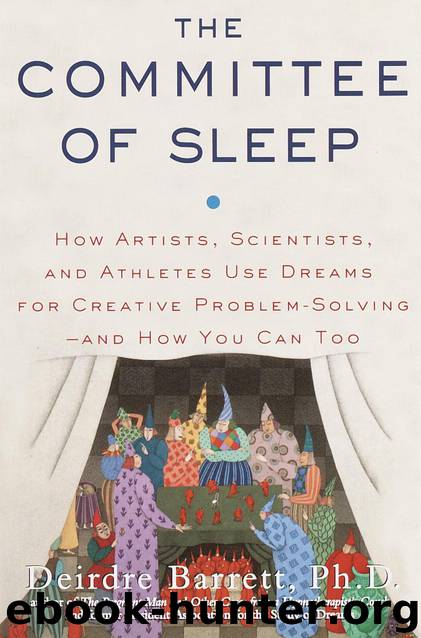The Committee of Sleep: How Artists, Scientists, and Athletes Use Dreams for Creative Problem Solving--and How You Can Too by Barrett Deirdre

Author:Barrett, Deirdre [Barrett, Deirdre]
Language: eng
Format: epub
Publisher: Unknown
Published: 2015-08-01T16:00:00+00:00
Ch
apter 6) Of Sewing Machines and Other Dreams: Inventions of the Committee
With giant telescopes trained on distant points in the galaxy, Paul Horowitz is a real-life version of Jodie Foster’s character in “Contact.” A Harvard physics professor, he’s noted for his work in radio astronomy. But his great passion is SETI--the Search for Extra-Terrestrial Intelligence. Horowitz builds telescopes for experimental astrophysics and negotiates a fraction of their stargazing time to search for signals from advanced life in other galaxies.
Most of his designs are radio telescopes because radio signals travel great distances in a focused form more easily than light. By the fall of 1998, however, laser technology had developed far enough that Horowitz decided to build the world’s first optical telescope to search for pulsed light signals. “There were literally an infinite number of ways we could put it together,” he recalls. “It’s not one big problem but lots of little ones. You figure out how to arrange one group of lenses, and then you design a circuit to manipulate that. There were many stages where we would get blocked on how to do something.”
And what would he do then?
Often I’d have a dream. These problem-solving dreams are not like my others. I’m simply an observer. They have a lot of clarity--there’s not the bizarreness of other dreams. These dreams have a narrator who’s sketching the problem verbally. Then the voice is giving the solution. I’m also seeing the solution. I watch a man working on the mechanical device--arranging lens for the optics or building the circuit--whatever it is that I’m stuck on at that point. The dream always takes it a slightly different way from what we’ve been trying awake.
I keep a pencil and paper next to the bed to write down these dreams,” Horowitz continues. “That’s the one way in which they are like other dreams--they’re beads of moisture on a very hot stove. They’ll evaporate in a second if I don’t get them down. I take my notes into work and tell my team ‘I’ve dreamed up a solution---literally.’ They’ve gotten quite used to doing things from my dreams.
On the laser telescope, Horowitz says he had at least three dreams about assembling optics and at least two about circuits--always visual aspects of the problems. He’s had similar dream series when working on radio telescope projects. They always occur in the middle of the night, after several hours of sleep. They overlap waking thought only in their clarity and degree of logic--he does not seem to be dozing like the dreamers in the last chapter.
With the last chapter’s examples of Einstein and painted natives in mind, I asked Horowitz if the narrator or the man he sees building telescopes remind him of anyone. “I guess they’re both most like me,” he says. “The voice sounds like mine and the man looks a lot like me. But I don’t think this during the dream. I’m just observing the solution.”
Horowitz’s dreams are exceptionally frequent and direct. But many other man-made devices have first functioned in a dream.
Download
This site does not store any files on its server. We only index and link to content provided by other sites. Please contact the content providers to delete copyright contents if any and email us, we'll remove relevant links or contents immediately.
Man and His Symbols by Carl Gustav Jung(3320)
[2004] Mass Psychology (Penguin Modern Classics) by Sigmund Freud(1168)
Angel Dreams by Virtue Doreen Virtue Melissa(1144)
God's Prophetic Symbolism in Everyday Life by Adam Thompson & Adrian Beale(1132)
Forgotten Language by Erich Fromm(1006)
Dreams by C. G. Jung(1002)
Inner Work by Johnson Robert A(974)
Mass Psychology (Penguin Modern Classics) by Sigmund Freud(968)
Conscious Dreaming: A Spiritual Path for Everyday Life by Robert Moss(965)
12,000 Dreams Interpreted by Linda Shields(960)
Inner Work Using Dreams & Active Imagination For Personal Growth - Robert A. Johnson by Robert A. Johnson(935)
Be Wise Now by Gael McCool(927)
The Art Of Dreaming by Carlos Castaneda(909)
Chicken Soup for the Soul by Amy Newmark & Kelly Sullivan Walden(905)
The Pizza Party by Theo Baker(903)
The Pagan Dream of the Renaissance by Joscelyn Godwin(875)
American Dreams by Unknown(860)
Leopard Warrior by John Lockley(843)
Conscious Dreaming by Robert Moss(833)
